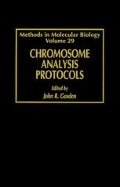Abstract
Hybrid cells are proving to be an important resource in the genetic analysis of chromosome regions. These hybrids may take the form of fusions between somatic cells from different genera, followed by selection for specific chromosome markers (somatic cell hybrids—see Chapter 17), the introduction of individual chromosomes into host cells of a different genus, and selection for the expression of specific genes (chromosome-mediated gene transfer, CMGT—see Chapter 20), or the introduction of a fragment of a mouse or human chromosome into a vector that can replicate as a chromosome in yeast cells (yeast artificial chromosomes, YACs—see Chapter 21). The donated material carried by the host cell can range from a small fragment of a chromosome (100 kbp to 1 or 2 Mbp) in a YAC to one or more complete chromosomes in the somatic cell hybrids. The donated material is known as a transgenome. In each of these cases, in order for the hybrid cell line to be of value as a resource for studying aspects of the human genome, it is essential that the precise chromosome composition of the transgenome is ascertained. The use of Southern hybridization to identify specific DNA segments carried by the transgenome is relatively straightforward (see Chapter 20). However, this method can only answer specific questions; in order to find out precisely which regions of the donor transgenome are present in the host cell, a different approach is needed.
Access this chapter
Tax calculation will be finalised at checkout
Purchases are for personal use only
References
Saiki, R K, Scharf, S J, Faloona, F., Mullis, K. B., Horn, G T, Ehrlich, H A., and Arnheim, N (1985) Enzymatic amplification of beta-globin genomic sequences and restriction site analysis of diagnosis of sickle ceil anemia. Science 230, 1350–1354
Bains, W. (1986) The multiple origins of human Alu sequences J. Mol Evol 23, 189–199.
Scott, A F, Schmeckpeper, B J, Abdelrazik, M, Comey, C. T., O’Hara, B, Rossiter, J. P., Cooley, T., Heath, P., Smith, K. D, and Margolet, L. (1987) Origin of the human LI elements, proposed progenitor genes deduced from a consensus sequence Genomics 1, 113–125
Bntten, R. J, Baron, W F, Stout, D. B., and Davidson, E H (1988) Sources and evolution of human Alu repeated sequences Proc Natl Acad Sci USA 85, 4770–4774
Singer, M F and Skowronski, J (1985) Making sense out of LINES’ long interspersed repeat sequences in mammalian genomes Trends Biochem Sci 10, 119–122
Lichter, P, Ledbetter, S A, Ledbetter, D H, and Ward, D C (1990) Fluorescence in situ hybridization with Alu and L1 polymerase chain reaction probes for rapid characterization of human chromosomes in hybrid cell lines. Proc Natl Acad. Sci USA 87, 6634–6638
Rychlik, W and Rhoads, R E (1989) A computer program for choosing optimal ohgonucleotides for filter hybridization, sequencing and in vitro amplification of DNA. Nucleic Acids Res 17, 8543–8551.
Rychhk, W, Spencer, W J., and Rhoads, R E (1990) Optimization of the annealing temperature for DNA amplification in vitro Nucleic Acids Res 18, 6409–6412.
Ledbetter, S A, Nelson, D. L, Warren, S T, and Ledbetter, D H (1990) Rapid isolation of DNA probes within specific chromosome regions by interspersed repetitive sequence polymerase chain reaction Genomics 6, 475–481
Author information
Authors and Affiliations
Editor information
Editors and Affiliations
Rights and permissions
Copyright information
© 1994 Humana Press Inc, Totowa, NJ
About this protocol
Cite this protocol
Gosden, J., Breen, M., Lawson, D. (1994). Alu- and LI-Primed PCR-Generated Probes for Nonisotopie in Situ Hybridization. In: Gosden, J.R. (eds) Chromosome Analysis Protocols. Methods in Molecular Biology™, vol 29. Humana Press. https://doi.org/10.1385/0-89603-289-2:479
Download citation
DOI: https://doi.org/10.1385/0-89603-289-2:479
Publisher Name: Humana Press
Print ISBN: 978-0-89603-289-7
Online ISBN: 978-1-59259-516-7
eBook Packages: Springer Protocols

